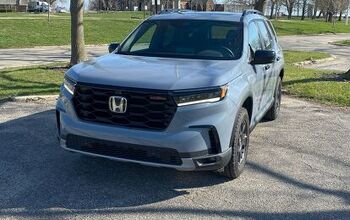July Makes It Official: Americans Buy More SUVs/Crossovers Than Cars
Six months ago, we said, “It’s about to happen.”
Well, it happened.
Americans took possession of more new SUVs and crossovers than cars in July 2016, a forecasted turn of events nevertheless made jarring by its sudden dawn.
Consumers purchased and leased nearly 610,000 SUVs and crossovers* in July. There was a significant 8 percent year-over-year increase during a month in which new vehicle volume barely expanded beyond its July 2015 output.
July 2016 also claimed a 9-percent year-over-year decline in passenger car volume*. That 57,000-unit decrease in car sales, married to the 46,000-unit SUV/crossover sales improvement, means utility vehicles outsold cars in the United States for the first time in July 2016.
CARS
(All 17 of those cars produced more than 2,000 July sales, hence the use of the relative “volume” term, and all declined by at least 20 percent, year-over-year.)
Meanwhile, other popular cars posted notable declines. The Toyota Camry slid 11 percent, Honda Accord sales were down 7 percent, and the Ford Fusion, Ford Focus, Hyundai Sonata, and Hyundai Elantra combined for nearly 9,000 lost sales.
As a result of these losses and many others, the passenger car sector’s market share tumbled four points from 43 percent in July 2015 to 39 percent in July 2016, losing a full point of market share compared with June 2016, as well.
ESS-YOU-VEES
Subcompact crossovers from Buick, Chevrolet, Honda, Jeep, and Mazda combined for a 40-percent, 10,000-unit year-over-year increase in July. Land Rover, the only premium brand that bothers not with passenger cars, jumped 21 percent. Cadillac’s SRX-replacing XT5 forsook its gradual start to claim second spot among premium brand SUVs/CUVs in July. Sales of the GM-controlled full-size SUV sector jumped 24 percent.
Yet the biggest factor behind the SUV/crossover sector’s rapid July growth was the explosive advances made by a handful of the most popular utility vehicles in America.
The Honda CR-V, America’s top-selling utility vehicle in the last four years, set an all-time monthly record with 36,017 July sales, a 13-percent year-over-year increase worth 4,232 additional sales.
The Nissan Rogue, which grabbed second spot in July with 33,298 sales, also set an all-time record, adding 8,217 sales to the SUV/crossover sector’s ledger compared with July 2015.
July’s third-ranked Toyota RAV4, the leading utility vehicle through the first seven months of 2016, broke its July record with 31,871 sales, a 19-percent year-over-year increase.
PACESETTERS
America’s three leading utility vehicles jumped 21 percent in July, producing 101,186 sales, 2,166 more than the three top cars.
The volume generated by America’s three leading passenger cars collectively slid 5 percent.
Look to your leaders.
*For the purposes of these tabulations, we included HybridCars.com estimates for the Tesla Model S (2,400) and Model X (1,500).
[Image: Land Rover, Mazda]
Timothy Cain is the founder of GoodCarBadCar.net, which obsesses over the free and frequent publication of U.S. and Canadian auto sales figures. Follow on Twitter @goodcarbadcar and on Facebook.
More by Timothy Cain
Latest Car Reviews
Read moreLatest Product Reviews
Read moreRecent Comments
- Buickman burn that oil!
- Jkross22 Meant to ask.... what's the best oil to use in a popcorn popper? I've been wanting to try peanut oil, but can't find anything smaller than the huge container at smart n final.
- Ajla A union fight? How retro 😎
- Analoggrotto Finally, some real entertainment: the Communists versus the MAGAs. FIGHT!
- Kjhkjlhkjhkljh kljhjkhjklhkjh *IF* i was buying a kia.. (better than a dodge from personal experience) .. it would be this Google > xoavzFHyIQYShould lead to a 2025 Ioniq 5 N pre-REVIEW by Jason Cammisa




































Comments
Join the conversation
That is precisely why I might not ever have another sedan, I am getting older and it is harder to get in most of the newer sedans and the side and rear visibility is not very good. My concern is that those remaining sedans like the Accord and Camry will eventually be the same as the other sedans with slopping roofs and smaller windows. At least the lower wider cars of the 60's had decent greenhouses and proper roof lines that made them easier to get in and out of. If anything there should be more head and leg room since the average person is physically bigger than people were 40 to 50 years ago. This same thing is true of airline seats which have gotten smaller with less leg room as the average person gets bigger.
The RAV4 Hybrid should be high on anyone's list, since it essentially eliminates the "CUV MPG Penalty". It's AWD, yet gets 10MPG more "city" rating, good acceleration, is only $2100 more than the FWD standard RAV4. All that with a "loss" of 2.8 cu. ft of cargo space behind the rear seats (35.6 vs. 38.4). Even with $2.50 gas, the payback period would be very short with a 10MPG better city mileage, and there is less-than-zero AWD penalty. I don't like the term all that much, but, it's a "no-brainer". I challenge GM/Chevy to get some Volt tech into the next Equinox PRONTO.